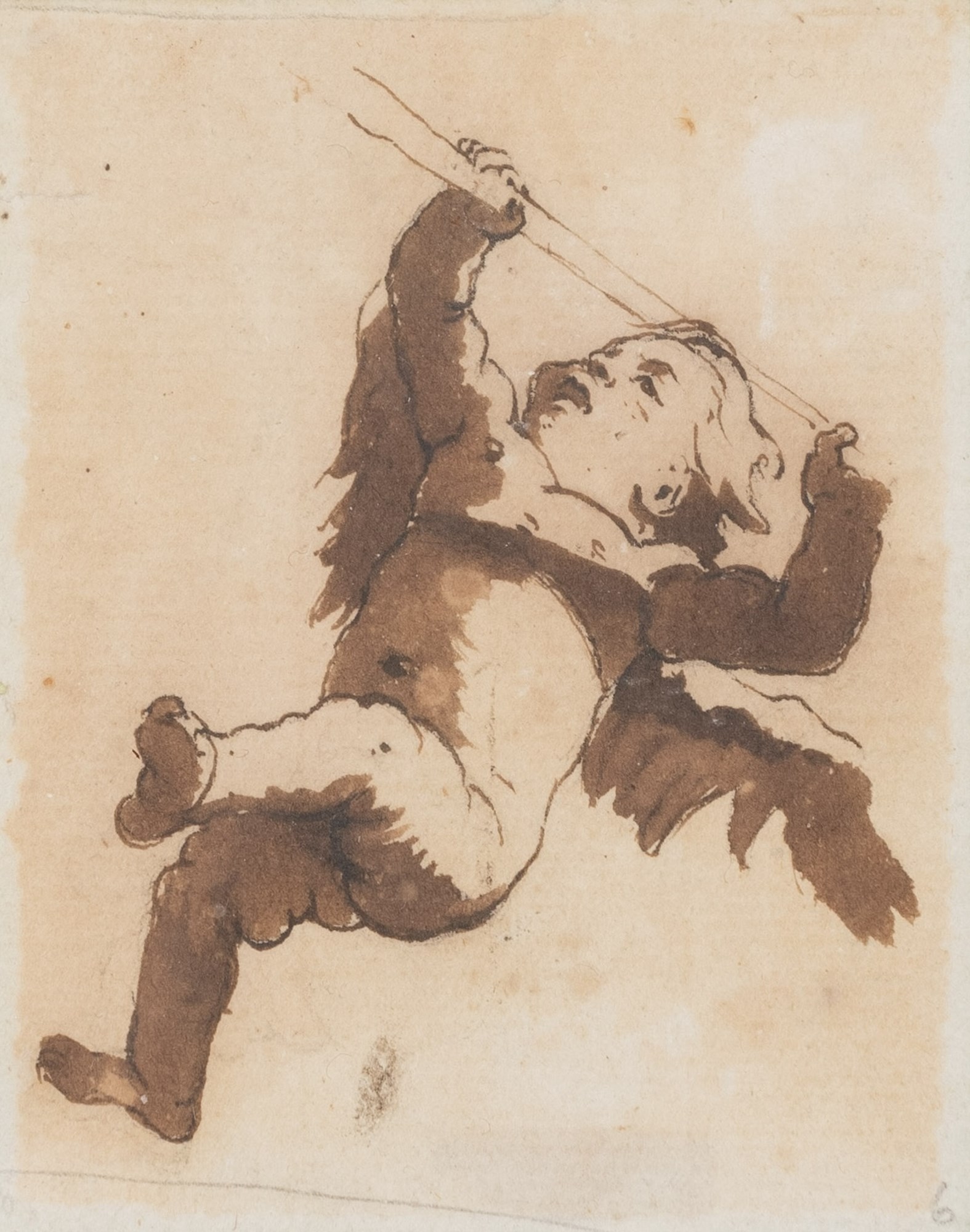Marketplace
A Winged Putto, Facing Left
Domenico Tiepolo treated the theme of winged cherubs at play in a large number of delightful pen and wash drawings, in almost all of which the putti are depicted flying among clouds. Although they sometimes accompany a saint, angels or God the Father, many of these charming drawings, as the scholar James Byam Shaw has noted, show ‘simply a swarm of winged putti in the clouds, without a central figure, sometimes evidently intended as part of some mythological or sacred theme...the little figures flock together and apart like birds, or tumble weightlessly in the air as though beyond the reach of gravity.’ Byam Shaw has further noted that, by comparison with the same artist’s series of drawings of the mythological theme of Hercules and Antaeus, ‘The compositions of Cherubs and Cupids…are more numerous and much more attractive, [and] are perhaps less homogenous, but may still be considered as a series, and were apparently numbered as such at an early date…In many of them Cupid is blindfold, tumbling about in the sky with other amoretti and playing with the doves of Venus; or driving gaily through the clouds in his mother’s chariot, brandishing bows and arrows…and sometimes the scene is set not in the clouds but on terra ferma, and the little creatures are simply naked children, without wings or bows and arrows or any of the accoutrements of pagan or Christian divinity.’
In his studies of cupids and cherubs, Domenico may have been inspired by some of the frescoes of similar frolicking putti and cherubs in the Villa Valmarana at Vicenza, where he worked with his father in 1757. A similar subject, with a blindfolded Cupid driving a chariot drawn by doves, also appears in an oval ceiling painting by Domenico of the 1760s or early 1770s, now in the Musée Rothschild-Ephrussi in Saint-Jean-Cap-Ferrat.
As Byam Shaw pointed out of Domenico’s drawings of this type, ‘it is sometimes hard to decide whether the flying cherubs are intended for the vision of a martyred saint or some other religious subject, or whether they are simply little creatures of the air cast for some secular or mythological allegory...It is difficult to see what Domenico’s purpose was in making so many drawings of such subjects – drawings that often bear contemporary numbers, like those of his other series...His ability to vary the composition and the individual figures, without ever (so far as I can discover) exactly repeating himself, is astonishing. Perhaps he was simply displaying his virtuosity, like a pianist improvising on his instrument. I cannot find that any of the drawings were directly used for paintings with Cupids and cherubs…Nor can I with confidence suggest any but an approximate date – that is, after Domenico’s return from Spain in 1770, when he turned more and more to drawing for its own sake.’
In his studies of cupids and cherubs, Domenico may have been inspired by some of the frescoes of similar frolicking putti and cherubs in the Villa Valmarana at Vicenza, where he worked with his father in 1757. A similar subject, with a blindfolded Cupid driving a chariot drawn by doves, also appears in an oval ceiling painting by Domenico of the 1760s or early 1770s, now in the Musée Rothschild-Ephrussi in Saint-Jean-Cap-Ferrat.
As Byam Shaw pointed out of Domenico’s drawings of this type, ‘it is sometimes hard to decide whether the flying cherubs are intended for the vision of a martyred saint or some other religious subject, or whether they are simply little creatures of the air cast for some secular or mythological allegory...It is difficult to see what Domenico’s purpose was in making so many drawings of such subjects – drawings that often bear contemporary numbers, like those of his other series...His ability to vary the composition and the individual figures, without ever (so far as I can discover) exactly repeating himself, is astonishing. Perhaps he was simply displaying his virtuosity, like a pianist improvising on his instrument. I cannot find that any of the drawings were directly used for paintings with Cupids and cherubs…Nor can I with confidence suggest any but an approximate date – that is, after Domenico’s return from Spain in 1770, when he turned more and more to drawing for its own sake.’
Provenance: Possibly Philip Uzielli, London
By descent to Isabelle de Waldner de Freundstein
Thence by descent.
More artworks from the Gallery





, 1994_T638389503811675926.jpg?width=500&height=500&mode=pad&scale=both&qlt=90&format=jpg)



